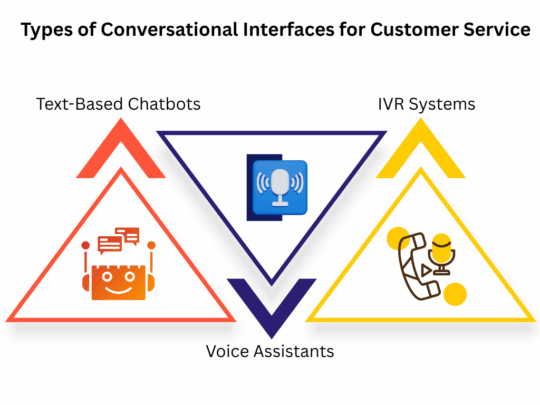Getting the work done by just saying something in your own language sounds interesting, right? To clarify, let us take an example: suggest the best restaurants near me, or simply ask for directions to a particular destination.
Welcome to the idea that conversational interfaces, where talking to machines isn’t just rocket science but reality, are here. There are no typing commands, no clicks, or anything else, just a simple conversation. Conversational interfaces are completely changing the way we engage in the digital world, replacing buttons with natural language.
A big move in how humans and technology interact. From customer support chatbots to AI voice assistants, these interfaces are transforming the digital world, making technology accessible to everyone. With this, human agents can focus on complex queries, while conversational AI can address common queries.
Dive into the blog to learn more about this standout conversation interface focused on customer service, alongside its types, importance, and more.
So, let’s get started.
What are Conversational Interfaces?
Conversational Interfaces (CUIs) are mainly user interfaces that allow individuals to interact with technology in a natural human language, through text (chatbots) or voice assistants. It starts sharing answers in conversational format rather than clicking on menus or buttons on the screen. Now, let’s mention the most common and popular CUI, “ChatGPT,” our beloved friend these days.
These interfaces use natural language processing and natural language understanding to communicate with the user in a human-like manner.
How Does Conversational AI for Customer Service Work?
Conversational AI, or CUI works based on NLP, large language models (LLMs), and ML technology to convert human language into machine readable language. Now, coming to the point, new technology plays a crucial role in customer service.
It understands customer needs, is available 24/7, and responds quickly to queries. The conversational AI keeps learning constantly from the user’s behavior and learns from each interaction. According to recent reports, the global conversational AI market is anticipated to grow from $12.24 billion in 2024 to $61.69 billion by 2032.
Types of Conversational Interfaces for Customer Service
There are different types of conversational interfaces. Which one to choose for your business totally depends on your needs and budget. Each technology comes with its unique aspects. Let us understand the types below:
Text-Based Chatbots
These are the most used in customer service or even e-commerce in answering queries, FAQs, recommending products, or more. Rather than browsing through multiple pages, customers can simply type out their needs and let the chatbot do the rest.
Voice Assistants
Let’s explain the voice assistant with the most common example: Alexa that can read news for you, play music, set reminders, and more. Using natural language processing, systems can understand and respond to voice commands on different devices such as mobile phones, computers, laptops, etc.
IVR (Interactive Voice Response) systems
These are automated phone systems enabling callers to obtain information and make requests using either their voice or keypad. Conversational AI enhances IVR by interpreting caller intent and resolving questions in a more direct way.
Benefits of Conversational Interfaces
- Quick Response Time: No longer wait for a long time to get your queries fixed. CUIs respond quickly, improving customer satisfaction.
- 24/7 Availability: No holidays! CUIs are here for you round the clock, ensuring you the best support, no matter the day or time.
- Reduce Operational Cost: You don’t need to invest in hiring large customer service teams. It can easily handle customer interactions.
- Interactive Communication: Conversations with CUIs are mainly engaging and natural wherein users are involved more.
Final Thoughts
Conversational interfaces have become much more than mere chat tools. They are changing the way we live, work, and interact. The division between man and machine interaction will still become blurred as these technologies become more mature and converged.
In the case of organizations, it is now time to act, start small, realistic experiments, experiment with real-world use cases, and expand to where you can measure an impact. The users who act promptly will not merely fulfill the expectations of customers that are on the rise, but they will provide what can be regarded as truly human-oriented digital experiences.
Check out our blog section for more insightful blog topics around tech.
FAQs
Q] Which is an example of a conversational interface?
Ans: Some of the common examples are Apple’s Siri, Amazon’s Alexa, and more.
Q] What is the main difference between chatbots and conversational UI?
Ans: Chabot's are here to handle simple queries, whereas conversational UI helps to address complex scenarios.
Suggested reading: AI in Customer Service: Beyond Chatbots for More Human Help





